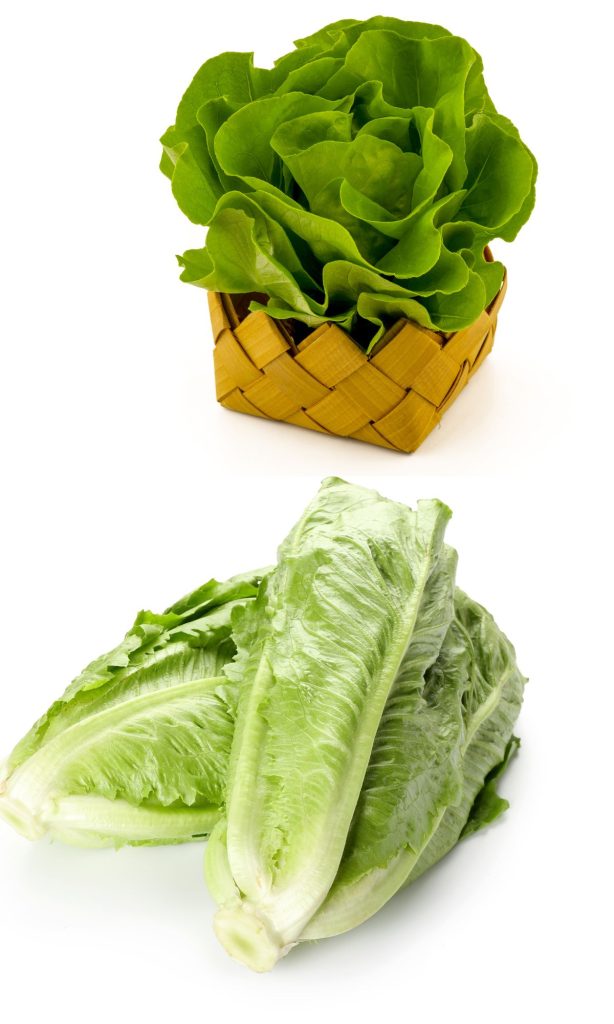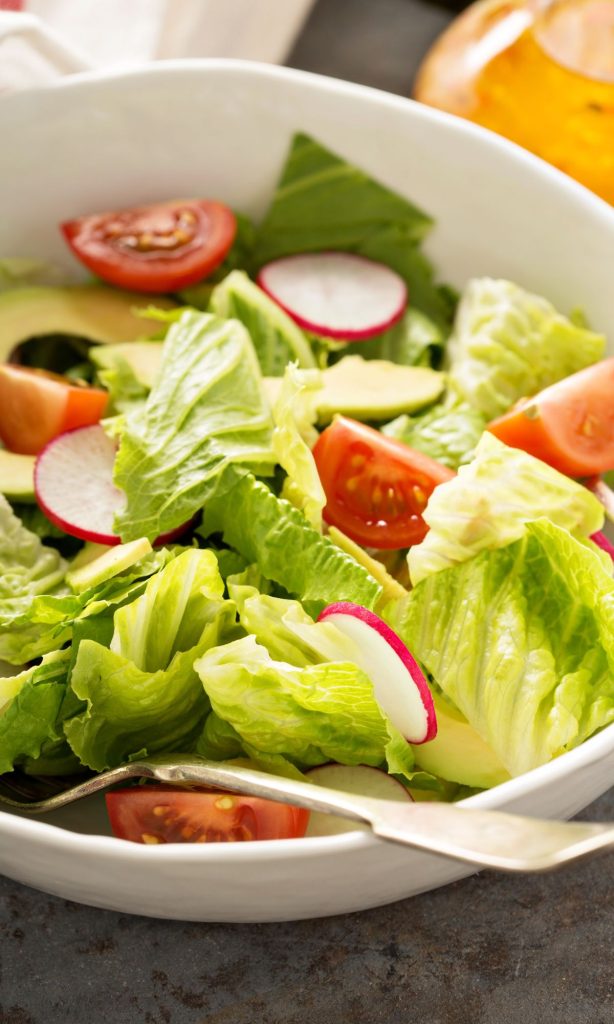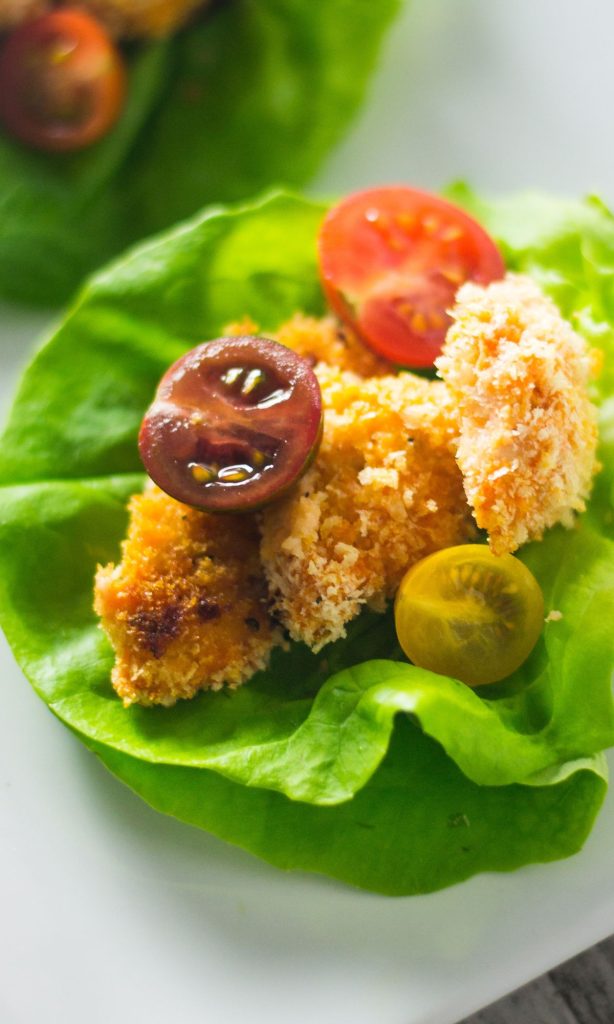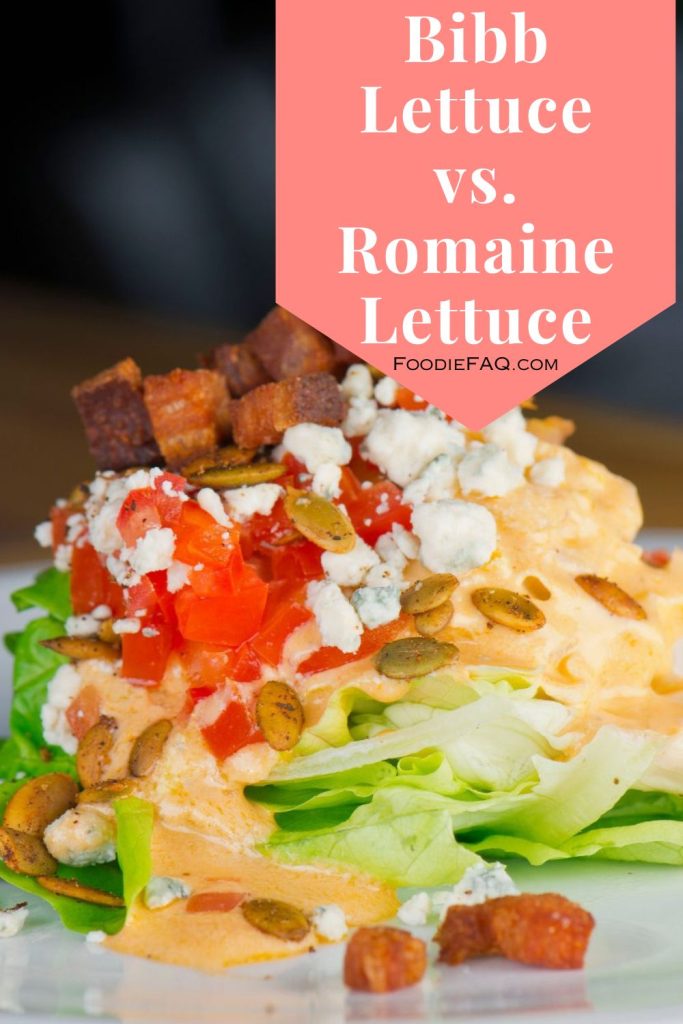I have been spending quite a bit of time learning about lettuce lately, which is a sentence I didn’t ever expect to write. However, I found myself down the rabbit hole because it can be a bit confusing when comparing lettuces. That is why today you will learn what I learned about Bibb lettuce vs romaine lettuce.

Overview of Romaine Lettuce
I love romaine lettuce and it is probably the most used in my house. We do get Bibb lettuce when we can but romaine is our go-to for just keeping it in the fridge at all times. It is so versatile which means we can make a quick salad or use it in our next tuna sandwich.
Description and Appearance
Romaine lettuce is a distinctive leafy green with several unique characteristics that set it apart from other lettuces. Here’s a breakdown of your statement:
- Elongated heads: Unlike the round heads of butterhead lettuces like Bibb or Boston, Romaine forms a tall, narrow head, often resembling a loaf of bread. This unique shape makes it easy to identify.
- Sturdy deep green leaves: Romaine leaves are thicker and more robust than many other lettuces, with a vibrant, deep green color. This contributes to its crisp texture and longer shelf life.
- Firm rib down the center: A prominent white or light green rib runs down the length of each Romaine leaf, providing structural support and adding a slightly crunchy bite.
- Upright growth: Unlike butterhead lettuces whose leaves curl inwards, Romaine leaves grow upwards and outwards, forming a loose, open head. This contributes to its crunchy texture and makes it easier to wash.
- Consistent color and distinctive ribbed leaves: The combination of the vibrant green leaves and the prominent white ribs creates a visually striking lettuce. This distinctive appearance, along with its elongated shape, makes Romaine instantly recognizable.
Taste and Texture
The taste of Romaine lettuce is fresh and mildly bitter, which is a nice contrast to sweeter salad ingredients. I appreciate its crunchiness, provided by the thick ribs, especially when the outer leaves are used. The inner leaves tend to be more tender and have a milder flavor, which I sometimes prefer in my sandwiches.
Overall, I personally prefer the greener portion of the leaves but my wife prefers the crunchier part of the leaves. So taste preferences do vary.
Culinary Uses of Romaine Lettuce
- Caesar Salads:
- Key Attribute: The crunchiness of Romaine is ideal for Caesar salads.
- Reason: It stands up well to rich, creamy dressings without wilting.
- Grilling:
- Advantage: Romaine leaves are sturdy, making them perfect for grilling.
- Result: They maintain structure and add a smoky flavor when grilled.
- Adding Crunch to Dishes:
- Versatility: Chopped Romaine can be added to taco salads and tacos.
- Benefit: Provides a refreshing crunch and nutritional boost.
- Healthy Alternative:
- Uses: Romaine leaves can substitute bread in wraps or burgers.
- Advantage: Offers a low-carb, gluten-free option that enhances the dish’s nutritional profile.

Overview of Bibb Lettuce
In this section, I’ll introduce you to Bibb lettuce, a variety that’s praised for its tender leaves and sweet flavor. I love Bibb lettuce. I love the silky texture and it is a fantastic lettuce for a homemade ranch dressing.
Description and Appearance
- Small and compact: Unlike the large, tightly packed heads of Romaine or iceberg lettuce, Bibb lettuce forms a much smaller, looser head. This makes it perfect for individual salads or small side dishes.
- Soft and pliable leaves: Bibb lettuce leaves are famously delicate and soft to the touch, earning it the “butterhead” label. They lack the crispness of other lettuces, but this contributes to their melt-in-your-mouth texture.
- Light green leaves: Bibb lettuce boasts a beautiful light green color, often with subtle variations and slightly frilled edges. This adds a touch of elegance to any dish.
- Less crisp, smooth, and tender: Compared to lettuces like iceberg or romaine, Bibb lettuce doesn’t offer the same satisfying crunch. However, its smooth, velvety texture and delicate nature are what truly set it apart. It’s perfect for adding a luxurious touch to salads, wraps, and even sandwiches.
Taste and Texture
I find Bibb lettuce to have a uniquely sweet and mild flavor, making it a delightful addition to any salad. The leaves possess a silky texture, which is a pleasurable contrast to the crunchy textures often found in other salad ingredients.
Culinary Uses of Bibb Lettuce
- Salads:
- Quality: Tender leaves make Bibb lettuce ideal for delicate salads.
- Flavor Profile: Adds a gentle sweetness and tender texture.
- Wraps:
- Functionality: Flexible leaves are perfect for wrapping tacos or other fillings.
- Benefit: Offers a healthier, lighter alternative to traditional wraps.
- Garnish:
- Aesthetic Appeal: Its rosette shape makes it a beautiful bed for presenting dishes.
- Versatility: Enhances the visual appeal of a variety of dishes.
- Perfect for Single Servings:
- Size Advantage: Smaller size makes it suitable for single-serve dishes and petite salads.
- Usage: Ideal for personal meals or when serving individual plates.

Comparison of Romaine Lettuce and Bibb Lettuce
Physical Characteristics
Romaine Lettuce:
- Tall and cylindrical shape
- Sturdy, long leaves that form a loaf-like head
Bibb Lettuce:
- Small, round and loosely-formed head
- Delicate, tender leaves
Size and Shape
Romaine Lettuce:
- Larger in size
- Leaves can grow up to 12 inches in length
Bibb Lettuce:
- Compact and smaller than romaine
- Generally grows between 4 to 6 inches in diameter
Color and Texture
Romaine Lettuce:
- Dark green leaves
- Crisp and crunchy texture
Bibb Lettuce:
- Light green leaves often with a slight reddish tinge on the edges
- Soft and buttery texture
Flavor Profile
Romaine Lettuce:
- Slightly bitter taste
- Bold, earthy flavor well-suited for hearty salads
Bibb Lettuce:
- Mild and sweet flavor
- Ideal for delicate dishes where a light taste is preferred
Shelf Life and Storage
In my experience, understanding the right way to store lettuce can significantly extend its shelf life. Let’s look at the specifics for Romaine and Butter lettuce.
Romaine Lettuce
Shelf life: I’ve found that Romaine lettuce typically lasts up to 10 days. However, if I keep it uncut, unwashed, and in a tightly sealed container, it can last for as long as 20 days.
Storage tips:
- Temperature: I always store my Romaine at a consistent temperature of about 32-36°F to prevent spoiling. Anything above 40°F may speed up bacterial growth.
- Humidity: A moderate level of humidity helps my Romaine stay crisp; too much and it wilts, too little and it dries out.
Butter Lettuce
Shelf life: When I buy Butter lettuce, it seems to last a bit shorter compared to Romaine. It generally stays fresh for about 3-5 days in the refrigerator.
Storage tips:
- Avoid washing: I’ve learned to store Butter lettuce without washing it until I’m ready to eat it to prevent excess moisture.
- Airtight container: Keeping it in an airtight container with a paper towel absorbs moisture and extends freshness.
Frequently Asked Questions
What are the nutritional differences between bibb lettuce and romaine lettuce?
Bibb lettuce, a type of butter lettuce known for its tender leaves, is a good source of vitamins A and K. Romaine lettuce, on the other hand, is notably high in vitamin A, vitamin K, and folate. It’s also known for having more fiber than bibb lettuce, which makes it a slightly more nutrient-dense option.
For details on the nutritional benefits of green leaf lettuce, a close relative of bibb, check out this informative piece on lettuce rankings.
How does the taste of bibb lettuce compare to that of romaine?
I find bibb lettuce to be mild, slightly sweet, and buttery, which complements a variety of dishes without overpowering other flavors. Romaine has a bit more of a crisp, fresh taste with a slightly bitter undertone. Its robust flavor holds up well in heartier salads and can offset the richness of dressings.
Can you explain the differences in texture between bibb lettuce and romaine?
Certainly! Bibb lettuce leaves are soft and tender with a smooth, buttery texture, making them perfect for use in delicate salads or as a wrap.
Romaine lettuce, contrastingly, has a crunchy texture with sturdy leaves that are ideal for grilling or adding a crisp element to sandwiches.
Here’s a guide that highlights romaine lettuce maintenance, which is directly related to its texture.
The bottom line
Well, that’s a wrap! These two lettuces really are quite different all the way down to the taste and texture. So which lettuce do you prefer?

